BUICK LESABRE 2004 Workshop Manual
Manufacturer: BUICK, Model Year: 2004, Model line: LESABRE, Model: BUICK LESABRE 2004Pages: 392, PDF Size: 4.3 MB
Page 51 of 392
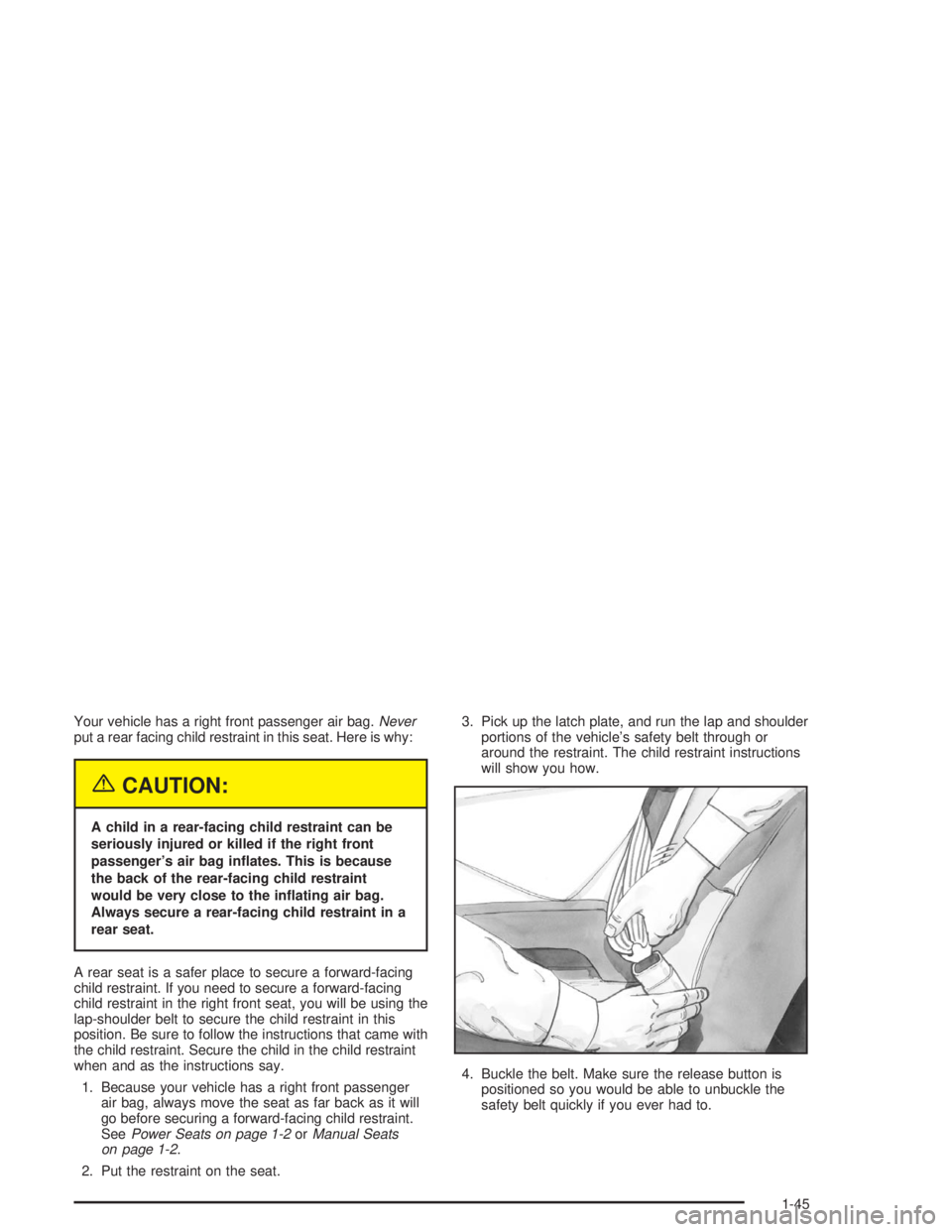
Your vehicle has a right front passenger air bag.Never
put a rear facing child restraint in this seat. Here is why:
{CAUTION:
A child in a rear-facing child restraint can be
seriously injured or killed if the right front
passenger’s air bag in�ates. This is because
the back of the rear-facing child restraint
would be very close to the in�ating air bag.
Always secure a rear-facing child restraint in a
rear seat.
A rear seat is a safer place to secure a forward-facing
child restraint. If you need to secure a forward-facing
child restraint in the right front seat, you will be using the
lap-shoulder belt to secure the child restraint in this
position. Be sure to follow the instructions that came with
the child restraint. Secure the child in the child restraint
when and as the instructions say.
1. Because your vehicle has a right front passenger
air bag, always move the seat as far back as it will
go before securing a forward-facing child restraint.
SeePower Seats on page 1-2orManual Seats
on page 1-2.
2. Put the restraint on the seat.3. Pick up the latch plate, and run the lap and shoulder
portions of the vehicle’s safety belt through or
around the restraint. The child restraint instructions
will show you how.
4. Buckle the belt. Make sure the release button is
positioned so you would be able to unbuckle the
safety belt quickly if you ever had to.
1-45
Page 52 of 392
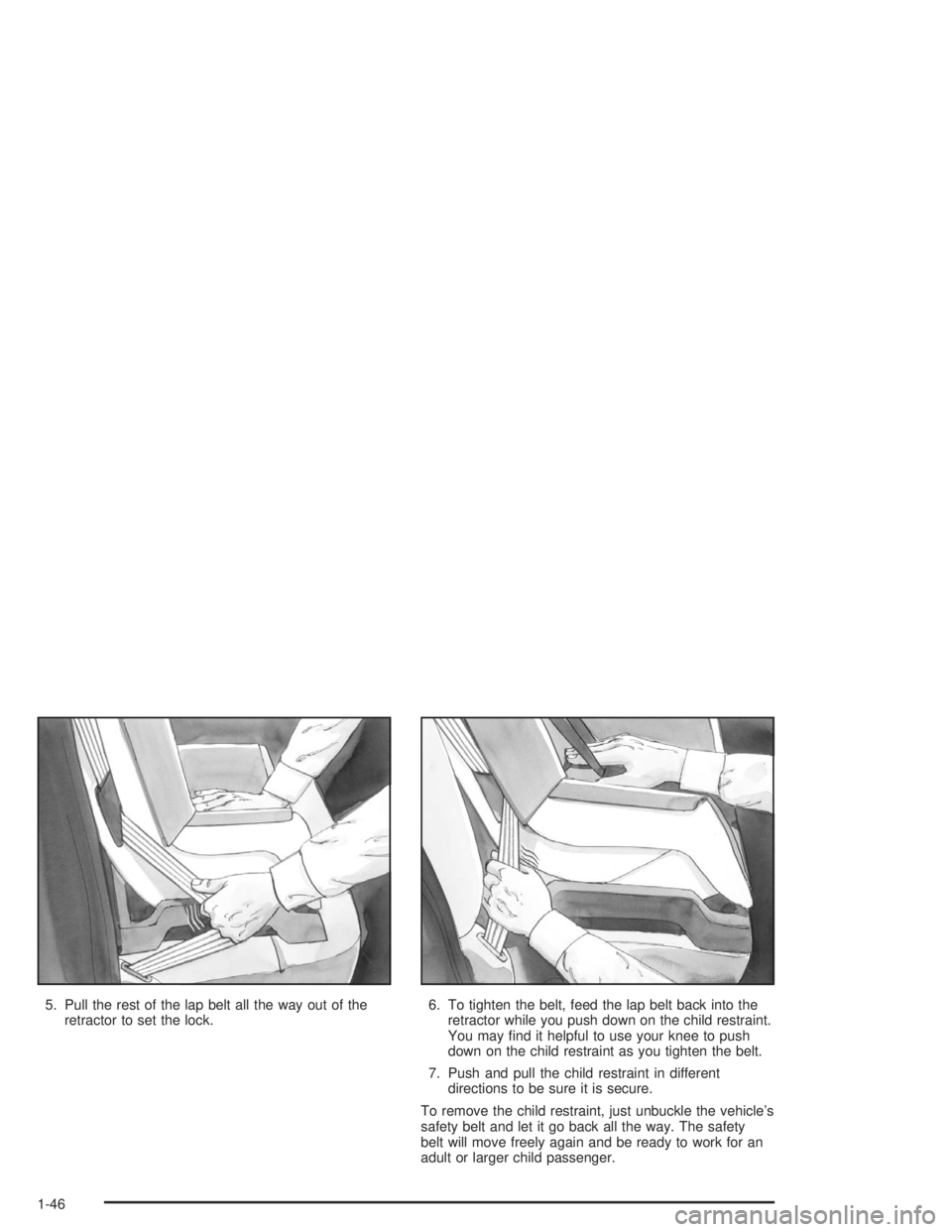
5. Pull the rest of the lap belt all the way out of the
retractor to set the lock.6. To tighten the belt, feed the lap belt back into the
retractor while you push down on the child restraint.
You may �nd it helpful to use your knee to push
down on the child restraint as you tighten the belt.
7. Push and pull the child restraint in different
directions to be sure it is secure.
To remove the child restraint, just unbuckle the vehicle’s
safety belt and let it go back all the way. The safety
belt will move freely again and be ready to work for an
adult or larger child passenger.
1-46
Page 53 of 392
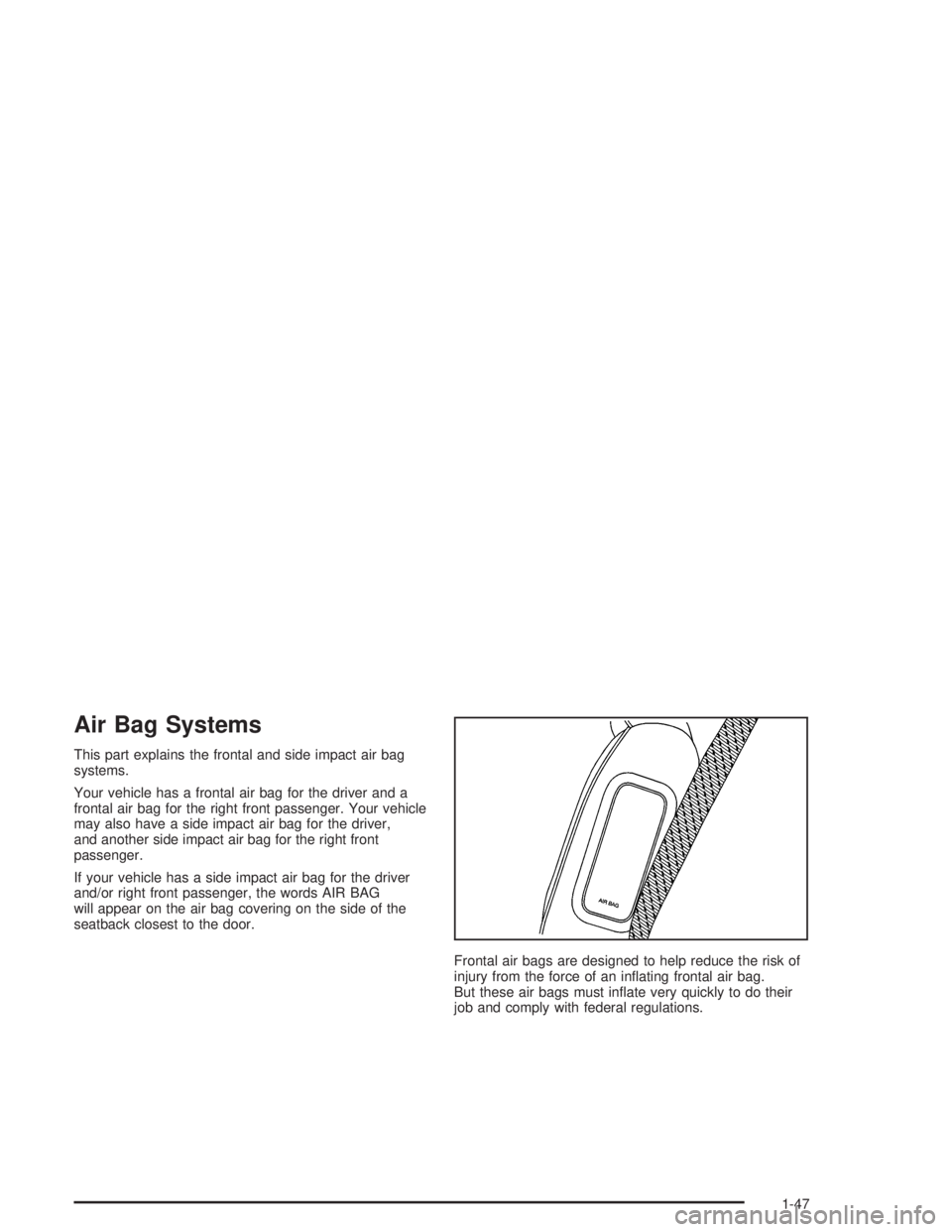
Air Bag Systems
This part explains the frontal and side impact air bag
systems.
Your vehicle has a frontal air bag for the driver and a
frontal air bag for the right front passenger. Your vehicle
may also have a side impact air bag for the driver,
and another side impact air bag for the right front
passenger.
If your vehicle has a side impact air bag for the driver
and/or right front passenger, the words AIR BAG
will appear on the air bag covering on the side of the
seatback closest to the door.
Frontal air bags are designed to help reduce the risk of
injury from the force of an in�ating frontal air bag.
But these air bags must in�ate very quickly to do their
job and comply with federal regulations.
1-47
Page 54 of 392
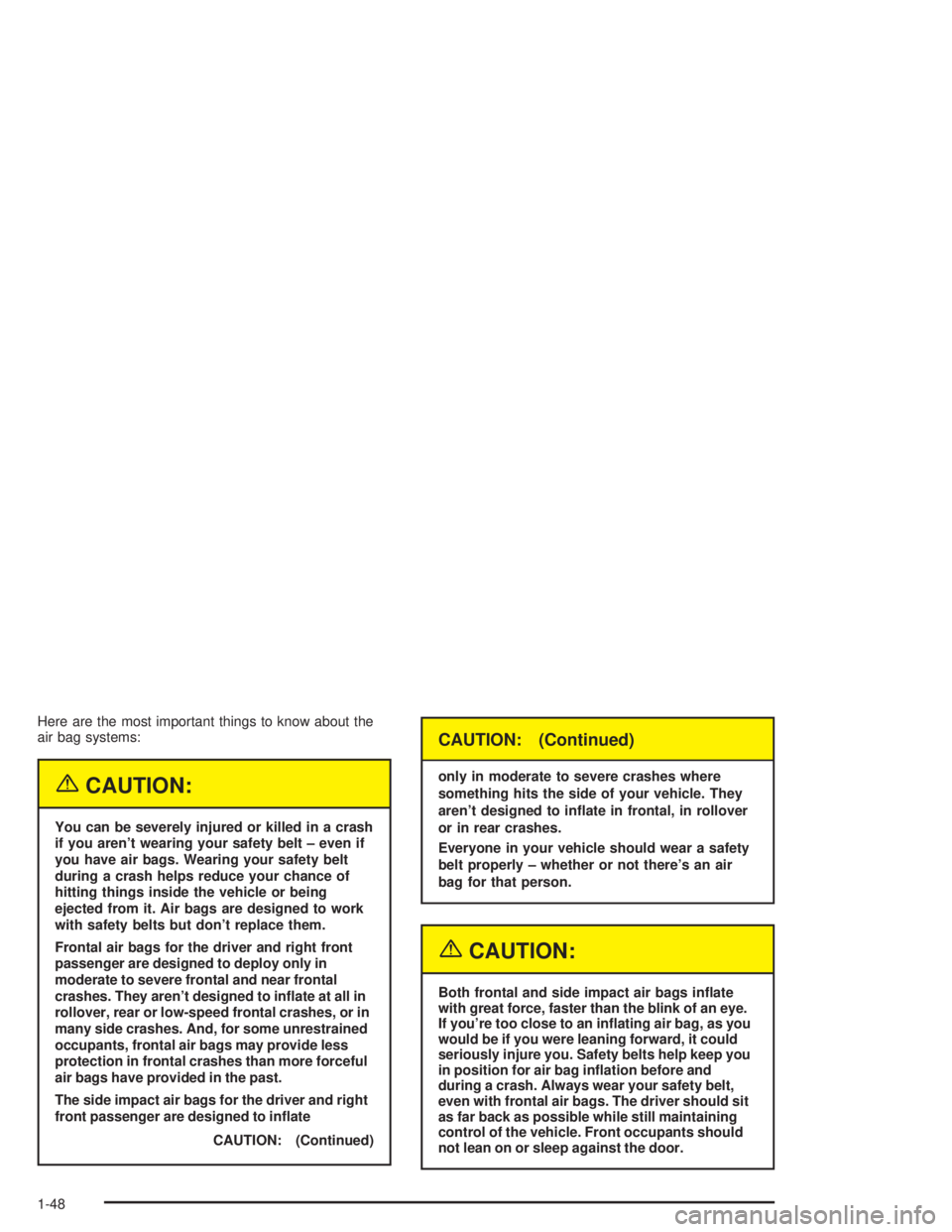
Here are the most important things to know about the
air bag systems:
{CAUTION:
You can be severely injured or killed in a crash
if you aren’t wearing your safety belt – even if
you have air bags. Wearing your safety belt
during a crash helps reduce your chance of
hitting things inside the vehicle or being
ejected from it. Air bags are designed to work
with safety belts but don’t replace them.
Frontal air bags for the driver and right front
passenger are designed to deploy only in
moderate to severe frontal and near frontal
crashes. They aren’t designed to in�ate at all in
rollover, rear or low-speed frontal crashes, or in
many side crashes. And, for some unrestrained
occupants, frontal air bags may provide less
protection in frontal crashes than more forceful
air bags have provided in the past.
The side impact air bags for the driver and right
front passenger are designed to in�ate
CAUTION: (Continued)
CAUTION: (Continued)
only in moderate to severe crashes where
something hits the side of your vehicle. They
aren’t designed to in�ate in frontal, in rollover
or in rear crashes.
Everyone in your vehicle should wear a safety
belt properly – whether or not there’s an air
bag for that person.
{CAUTION:
Both frontal and side impact air bags in�ate
with great force, faster than the blink of an eye.
If you’re too close to an in�ating air bag, as you
would be if you were leaning forward, it could
seriously injure you. Safety belts help keep you
in position for air bag in�ation before and
during a crash. Always wear your safety belt,
even with frontal air bags. The driver should sit
as far back as possible while still maintaining
control of the vehicle. Front occupants should
not lean on or sleep against the door.
1-48
Page 55 of 392
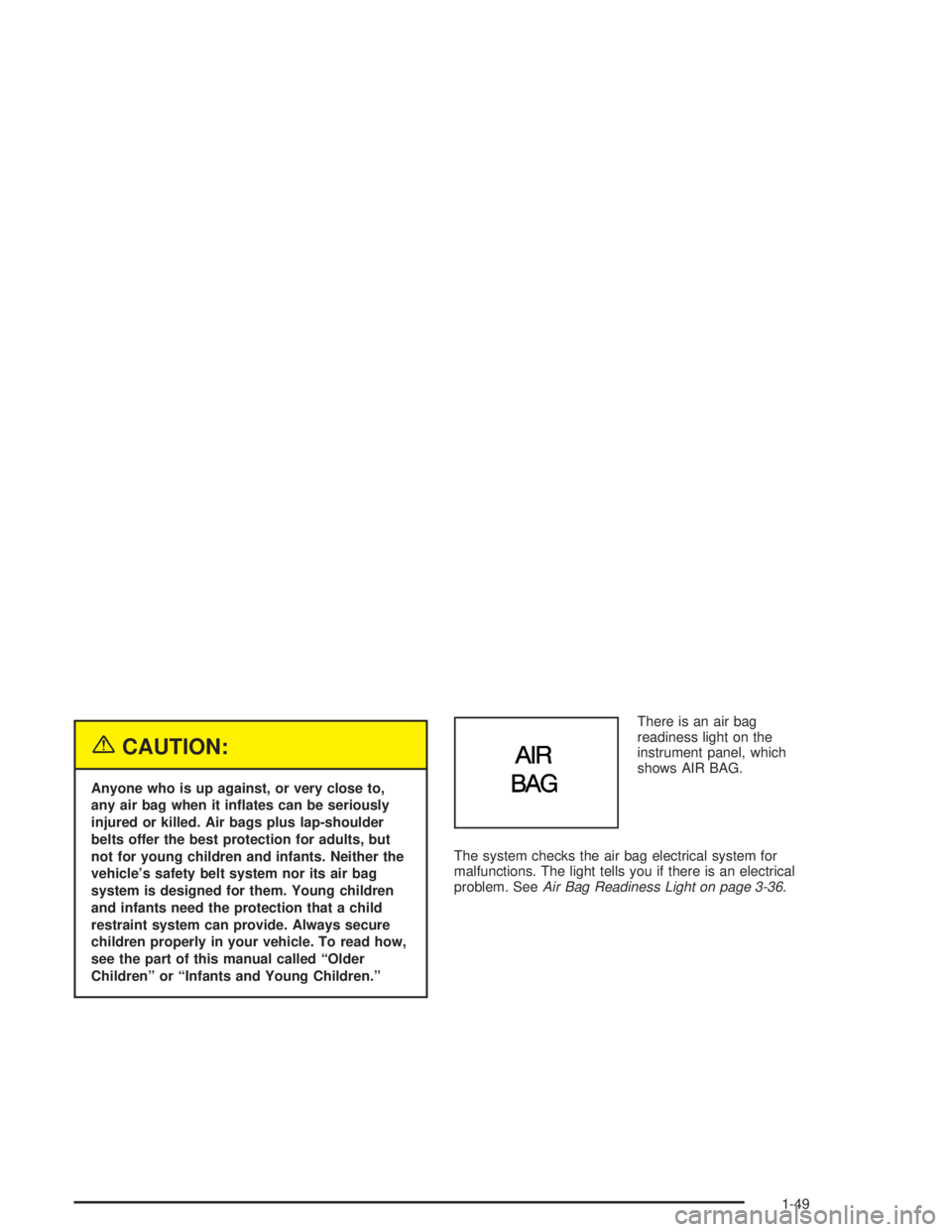
{CAUTION:
Anyone who is up against, or very close to,
any air bag when it in�ates can be seriously
injured or killed. Air bags plus lap-shoulder
belts offer the best protection for adults, but
not for young children and infants. Neither the
vehicle’s safety belt system nor its air bag
system is designed for them. Young children
and infants need the protection that a child
restraint system can provide. Always secure
children properly in your vehicle. To read how,
see the part of this manual called “Older
Children” or “Infants and Young Children.”There is an air bag
readiness light on the
instrument panel, which
shows AIR BAG.
The system checks the air bag electrical system for
malfunctions. The light tells you if there is an electrical
problem. SeeAir Bag Readiness Light on page 3-36.
1-49
Page 56 of 392
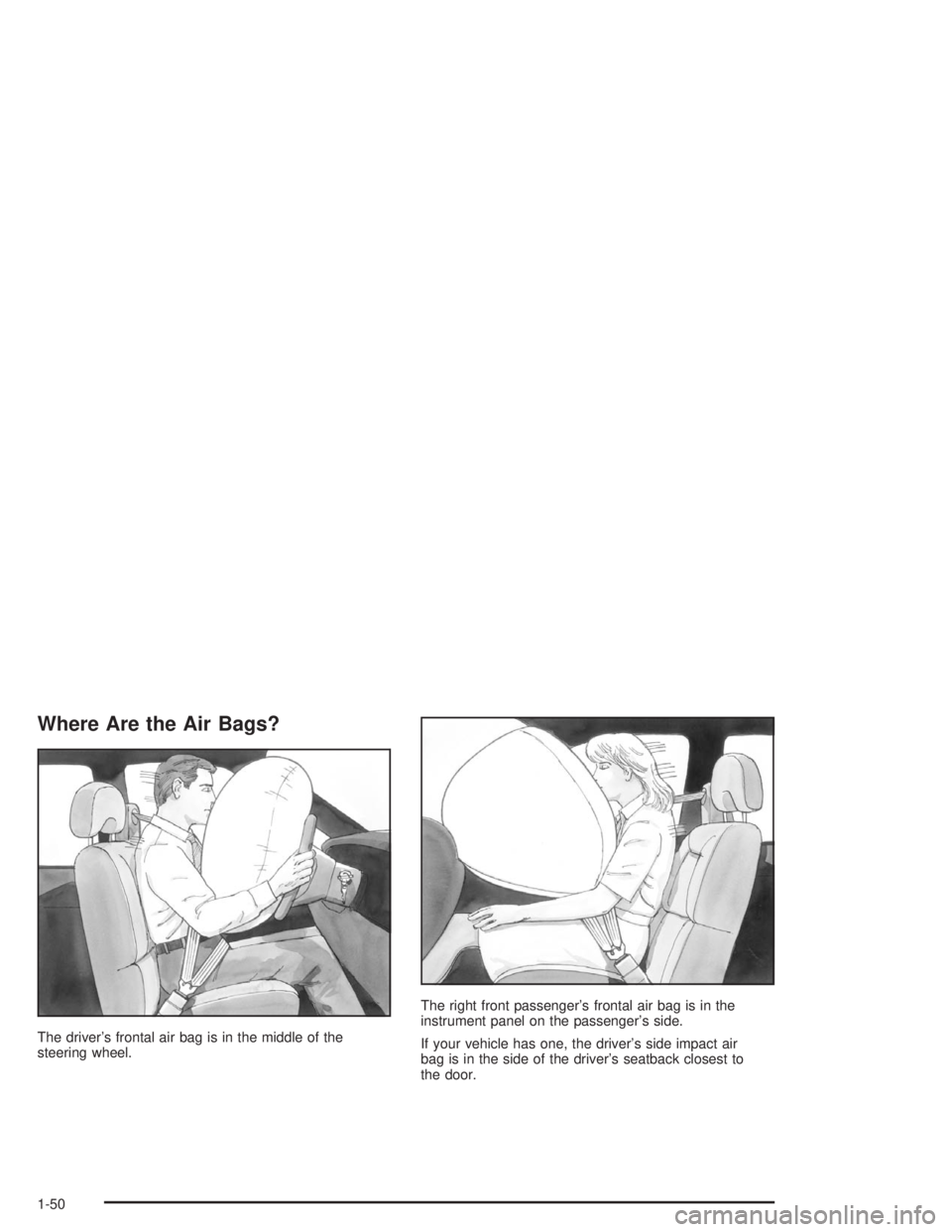
Where Are the Air Bags?
The driver’s frontal air bag is in the middle of the
steering wheel.The right front passenger’s frontal air bag is in the
instrument panel on the passenger’s side.
If your vehicle has one, the driver’s side impact air
bag is in the side of the driver’s seatback closest to
the door.
1-50
Page 57 of 392
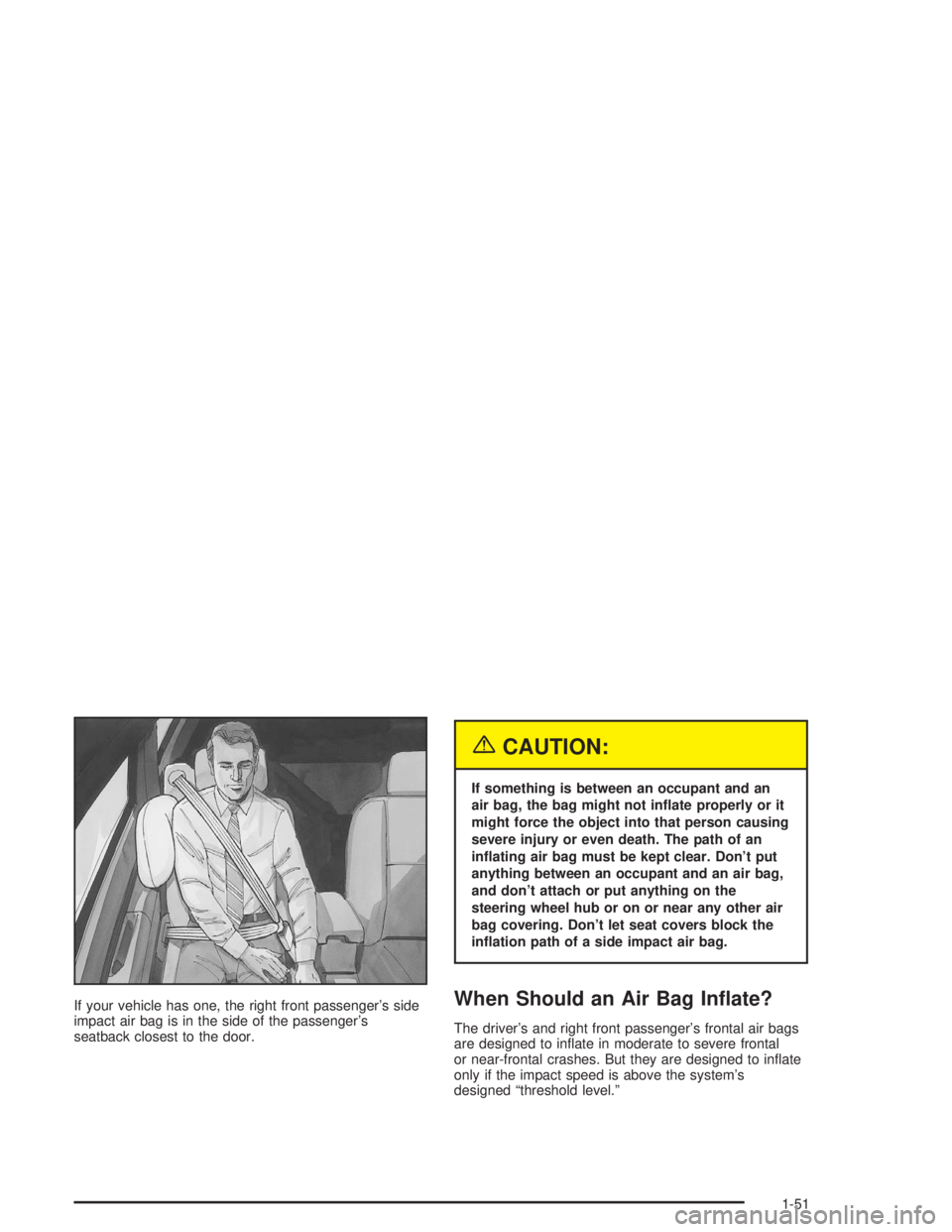
If your vehicle has one, the right front passenger’s side
impact air bag is in the side of the passenger’s
seatback closest to the door.
{CAUTION:
If something is between an occupant and an
air bag, the bag might not in�ate properly or it
might force the object into that person causing
severe injury or even death. The path of an
in�ating air bag must be kept clear. Don’t put
anything between an occupant and an air bag,
and don’t attach or put anything on the
steering wheel hub or on or near any other air
bag covering. Don’t let seat covers block the
in�ation path of a side impact air bag.
When Should an Air Bag In�ate?
The driver’s and right front passenger’s frontal air bags
are designed to in�ate in moderate to severe frontal
or near-frontal crashes. But they are designed to in�ate
only if the impact speed is above the system’s
designed “threshold level.”
1-51
Page 58 of 392
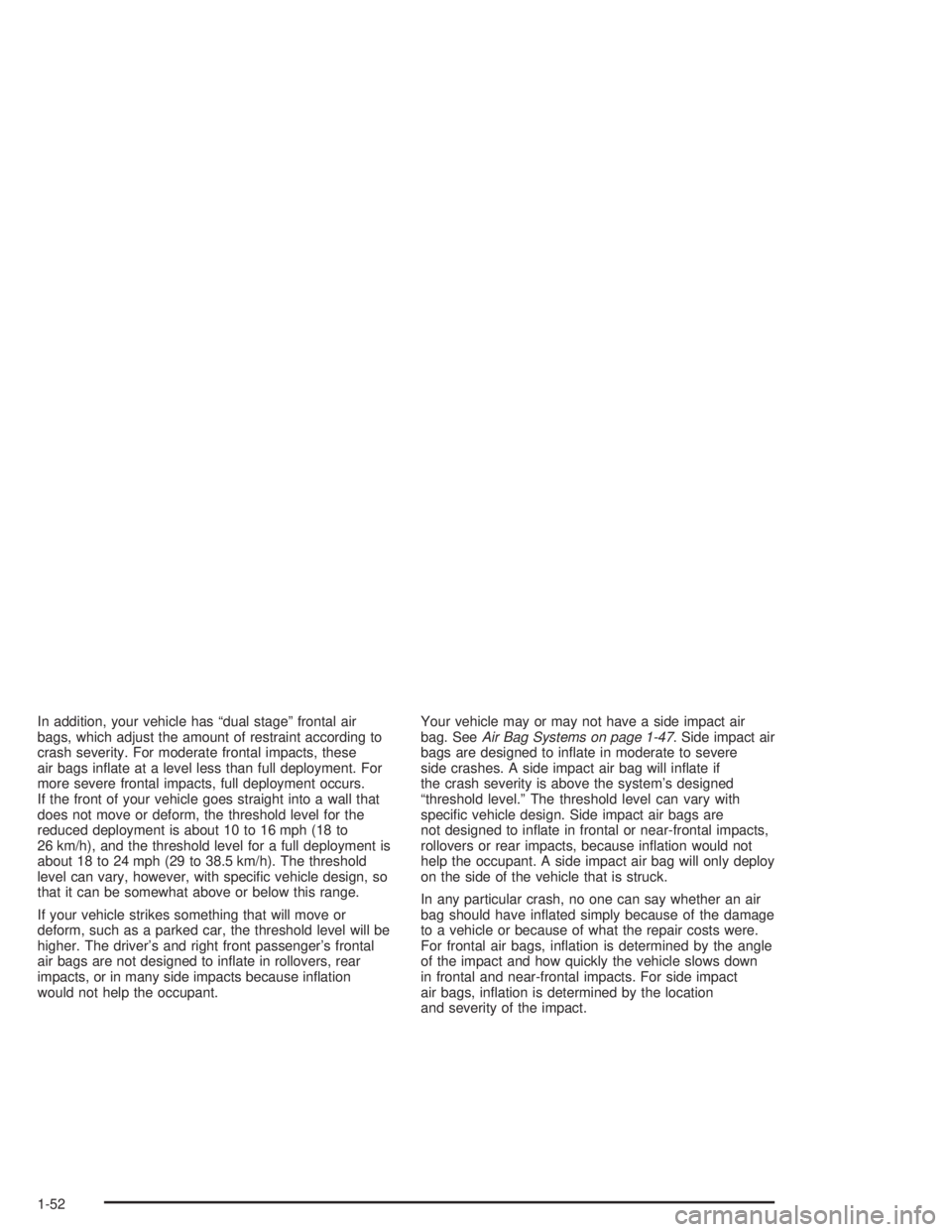
In addition, your vehicle has “dual stage” frontal air
bags, which adjust the amount of restraint according to
crash severity. For moderate frontal impacts, these
air bags in�ate at a level less than full deployment. For
more severe frontal impacts, full deployment occurs.
If the front of your vehicle goes straight into a wall that
does not move or deform, the threshold level for the
reduced deployment is about 10 to 16 mph (18 to
26 km/h), and the threshold level for a full deployment is
about 18 to 24 mph (29 to 38.5 km/h). The threshold
level can vary, however, with speci�c vehicle design, so
that it can be somewhat above or below this range.
If your vehicle strikes something that will move or
deform, such as a parked car, the threshold level will be
higher. The driver’s and right front passenger’s frontal
air bags are not designed to in�ate in rollovers, rear
impacts, or in many side impacts because in�ation
would not help the occupant.Your vehicle may or may not have a side impact air
bag. SeeAir Bag Systems on page 1-47. Side impact air
bags are designed to in�ate in moderate to severe
side crashes. A side impact air bag will in�ate if
the crash severity is above the system’s designed
“threshold level.” The threshold level can vary with
speci�c vehicle design. Side impact air bags are
not designed to in�ate in frontal or near-frontal impacts,
rollovers or rear impacts, because in�ation would not
help the occupant. A side impact air bag will only deploy
on the side of the vehicle that is struck.
In any particular crash, no one can say whether an air
bag should have in�ated simply because of the damage
to a vehicle or because of what the repair costs were.
For frontal air bags, in�ation is determined by the angle
of the impact and how quickly the vehicle slows down
in frontal and near-frontal impacts. For side impact
air bags, in�ation is determined by the location
and severity of the impact.
1-52
Page 59 of 392
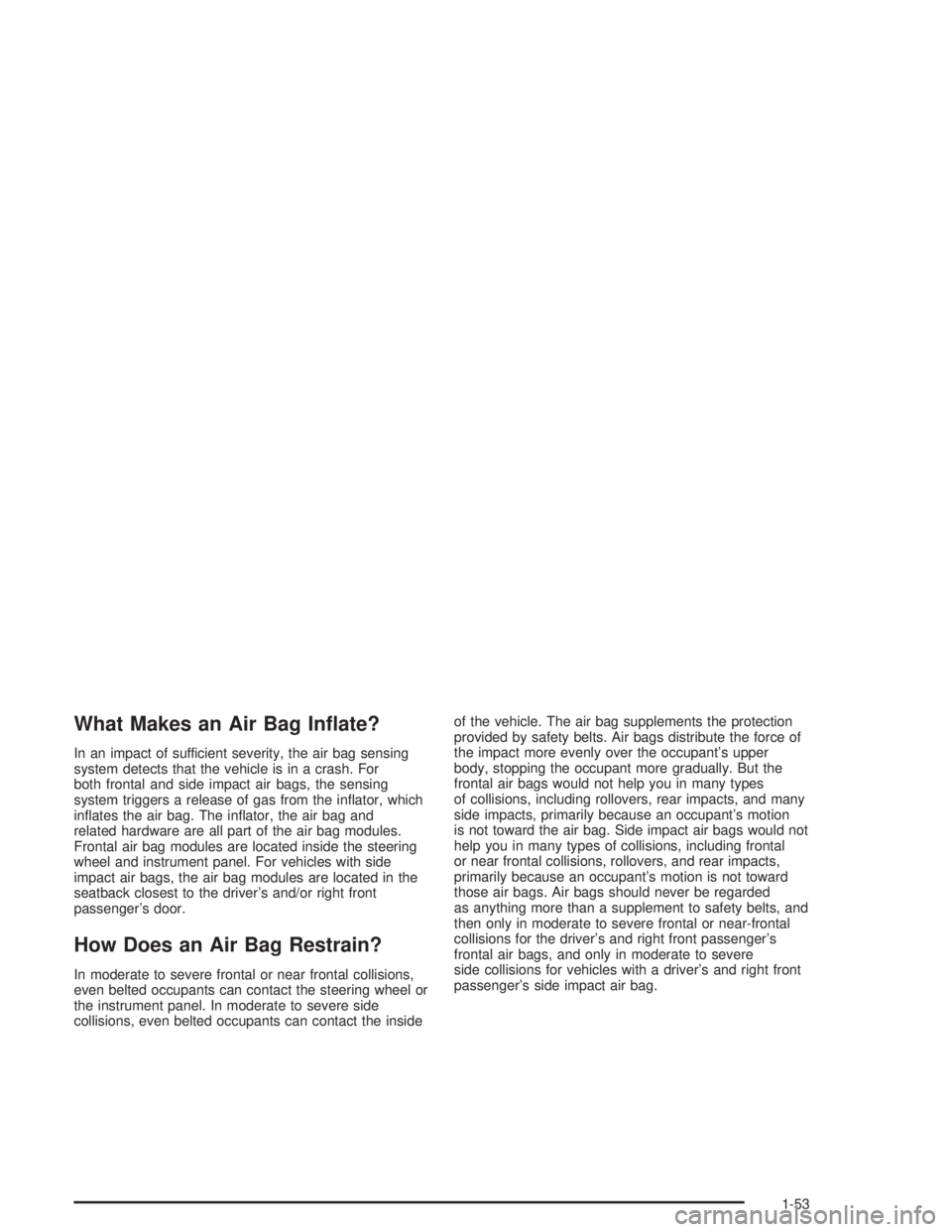
What Makes an Air Bag In�ate?
In an impact of sufficient severity, the air bag sensing
system detects that the vehicle is in a crash. For
both frontal and side impact air bags, the sensing
system triggers a release of gas from the in�ator, which
in�ates the air bag. The in�ator, the air bag and
related hardware are all part of the air bag modules.
Frontal air bag modules are located inside the steering
wheel and instrument panel. For vehicles with side
impact air bags, the air bag modules are located in the
seatback closest to the driver’s and/or right front
passenger’s door.
How Does an Air Bag Restrain?
In moderate to severe frontal or near frontal collisions,
even belted occupants can contact the steering wheel or
the instrument panel. In moderate to severe side
collisions, even belted occupants can contact the insideof the vehicle. The air bag supplements the protection
provided by safety belts. Air bags distribute the force of
the impact more evenly over the occupant’s upper
body, stopping the occupant more gradually. But the
frontal air bags would not help you in many types
of collisions, including rollovers, rear impacts, and many
side impacts, primarily because an occupant’s motion
is not toward the air bag. Side impact air bags would not
help you in many types of collisions, including frontal
or near frontal collisions, rollovers, and rear impacts,
primarily because an occupant’s motion is not toward
those air bags. Air bags should never be regarded
as anything more than a supplement to safety belts, and
then only in moderate to severe frontal or near-frontal
collisions for the driver’s and right front passenger’s
frontal air bags, and only in moderate to severe
side collisions for vehicles with a driver’s and right front
passenger’s side impact air bag.
1-53
Page 60 of 392
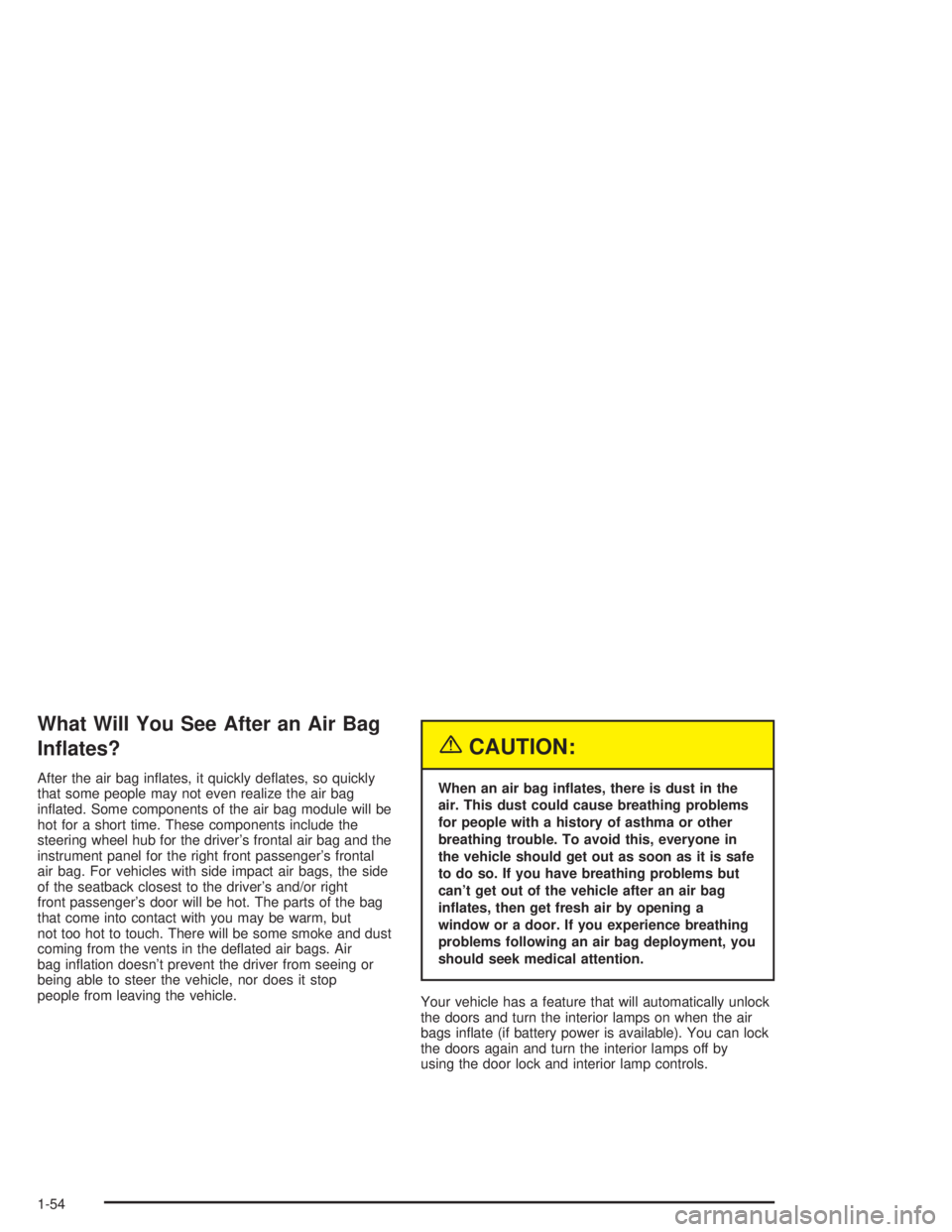
What Will You See After an Air Bag
In�ates?
After the air bag in�ates, it quickly de�ates, so quickly
that some people may not even realize the air bag
in�ated. Some components of the air bag module will be
hot for a short time. These components include the
steering wheel hub for the driver’s frontal air bag and the
instrument panel for the right front passenger’s frontal
air bag. For vehicles with side impact air bags, the side
of the seatback closest to the driver’s and/or right
front passenger’s door will be hot. The parts of the bag
that come into contact with you may be warm, but
not too hot to touch. There will be some smoke and dust
coming from the vents in the de�ated air bags. Air
bag in�ation doesn’t prevent the driver from seeing or
being able to steer the vehicle, nor does it stop
people from leaving the vehicle.
{CAUTION:
When an air bag in�ates, there is dust in the
air. This dust could cause breathing problems
for people with a history of asthma or other
breathing trouble. To avoid this, everyone in
the vehicle should get out as soon as it is safe
to do so. If you have breathing problems but
can’t get out of the vehicle after an air bag
in�ates, then get fresh air by opening a
window or a door. If you experience breathing
problems following an air bag deployment, you
should seek medical attention.
Your vehicle has a feature that will automatically unlock
the doors and turn the interior lamps on when the air
bags in�ate (if battery power is available). You can lock
the doors again and turn the interior lamps off by
using the door lock and interior lamp controls.
1-54